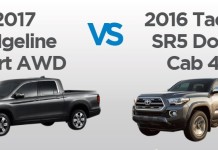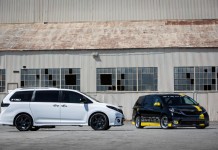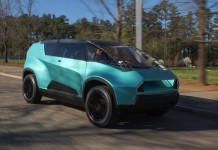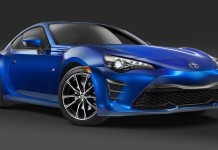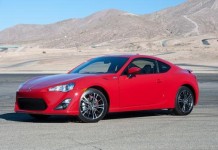Based on the Corolla platform, the 2007 Toyota Matrix aims to combine the interior functionality and flexibility of a small SUV with the driving characteristics of a sporty compact car. It’s part of a growing list of sporty and affordable four-door hatchbacks/wagons like the Chevrolet HHR, Chrysler PT Cruiser, Dodge Caliber and Mazda 3 hatchback.
On the outside, the Toyota Matrix has a more angular front fascia, including its own grille, headlights and taillights. And while the Corolla has a traditional, smooth-bodied profile, the Matrix benefits from a little more style, with an S-shaped character line that breaks up what would otherwise be a rather boxy side.
The Matrix stands tall — 5 inches taller than the Corolla — which gives the cabin a spacious feel. This also allows it to accommodate adults comfortably in the backseat. For carrying cargo, the Matrix features a durable plastic cargo floor with built-in tracks and adjustable tie-down points. What’s more, both the rear seats and the front passenger seat fold perfectly flat to allow owners to transport items up to 8 feet in length.
We’re convinced that the 2007 Toyota Matrix would be a satisfying choice for many people. It rides comfortably, handles decently and has plenty of room in the rear for friends, children or cargo. True, it’s not as sporty or as fun as the Mazda 3 (especially with this year’s discontinuation of the sporty XRS trim), but it is one of the best small wagons in its class in terms of value, build quality and features. Alternately, if you like slightly more American styling, opt for the Pontiac Vibe, as it shares much of the Matrix’s mechanicals but has a distinct Pontiac look.
Body Styles, Trim Levels, and Options
The 2007 Toyota Matrix compact wagon is available in two trim levels: base and XR. Base-level cars have the necessities such as air-conditioning and a CD player, but most of the worthwhile features are optional. Go with the XR to get standard power locks and windows, keyless entry, a 115-volt power outlet and a rear wiper. Options depending on trim level include 16- or 17-inch aluminum alloy wheels, an all-weather package, a moonroof and a JBL premium sound system with CD changer. There’s also a special Matrix M-Theory package for the XR. Available with the Speedway Blue exterior paint only, it includes special 17-inch wheels, a sport-tuned suspension, a front strut tower brace and four-wheel disc brakes.
Powertrains and Performance
The Toyota Matrix comes with a 1.8-liter four-cylinder engine. The engine makes 126 horsepower and 122 pound-feet of torque. A five-speed manual transmission is standard and a four-speed automatic is optional. EPA estimates Matrix fuel economy at 30 city/36 highway for cars equipped with a manual and 29 city/34 highway for cars with an automatic transmission.
Safety
ABS is optional on all 2007 Toyota Matrix wagons. The M-Theory adds four-wheel disc brakes; otherwise, the Matrix comes with rear drums. Seat-mounted side airbags for front occupants and full-length side curtain airbags are optional across the line. Stability control is another worthwhile option, but it’s offered only on the XR and only with an automatic transmission. In NHTSA crash testing, the Toyota Matrix earned five stars (the best score possible) for driver protection in frontal impacts and four stars for the front passenger. For side impacts, a Matrix without side airbags received three stars for front-passenger protection and four stars for rear-passenger protection.
Interior Design and Special Features
The 2007 Toyota Matrix offers an attractive interior design with a simple control layout. Most materials are of solid quality, and fit and finish is typically above average for this class. The driving position can be a bit awkward for taller drivers, but the rear seat is roomy and comfortable and even adults will be content to ride in back. In terms of cargo-carrying ability, the Matrix is similar to a small SUV. The rear hatch opens upward, and the rear glass can be raised independently. The main cargo area and rear seatbacks are unapologetically coated in hard plastic, the idea being that it’s a lot easier to clean dirt and mud off one long expanse of plastic than out of matted carpet. A special cargo-floor track features eight adjustable tie-down hooks. Underneath the floor is a hidden storage compartment. The 60/40-split rear seats can be folded flat, thereby expanding cargo room to 53.2 cubic feet. The front passenger seat also folds forward, allowing items more than 8 feet long to be carried with the tailgate closed.
Driving Impressions
Despite Toyota’s claims, the Matrix isn’t particularly sporty. Acceleration is only average, but the manual transmission cars do give a little extra snap. Handling, too, is modest but should be fine for most customers who are looking for a maneuverable suburban runabout as opposed to a serious sport wagon. The Matrix’s ride quality is smooth and comfortable, making it a fine choice for commutes and road trips.
| Exterior |
| Length: 171.3 in. | Width: 69.9 in. |
| Height: 61.6 in. | Wheel Base: 102.4 in. |
| Ground Clearance: 5.9 in. | Curb Weight: 2679 lbs. |
| Interior |
| Front Head Room: 40.6 in. | Front Hip Room: 51.7 in. |
| Front Shoulder Room: 53.2 in. | Rear Head Room: 39.8 in. |
| Rear Shoulder Room: 52.6 in. | Rear Hip Room: 47.8 in. |
| Front Leg Room: 41.8 in. | Rear Leg Room: 36.3 in. |
| Luggage Capacity: 21.8 cu. ft. | Maximum Cargo Capacity: 53 cu. ft. |
| Maximum Seating: 5 |
| Performance |
| Base Number of Cylinders: 4 | Base Engine Size: 1.8 liters |
| Base Engine Type: Inline 4 | Horsepower: 126 hp |
| Max Horsepower: 6000 rpm | Torque: 122 ft-lbs. |
| Max Torque: 4200 rpm | Drive Type: FWD |
| Turning Circle: 36.8 ft. |
| Fuel |
| Fuel Tank Capacity: 13.2 gal. | |
| EPA Mileage Estimates: (City/Highway) |
| Manual: 30 mpg / 36 mpg | |
| Range in Miles: (City/Highway) |
| Manual: 396 mi. / 475.2 mi. |
Source: Edmunds

